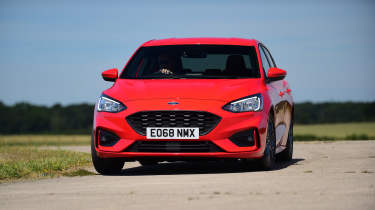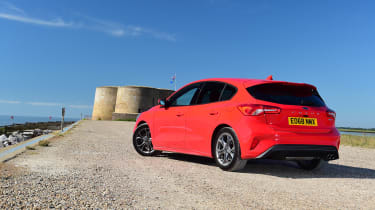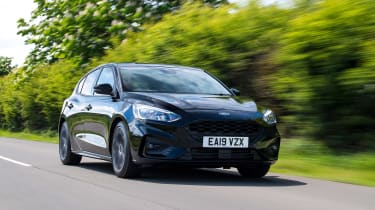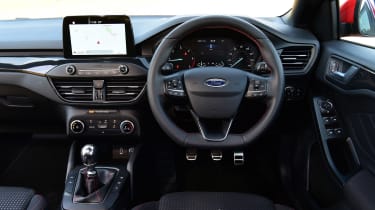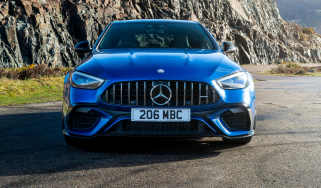2019 Ford Focus EcoBoost review – a family favourite past its prime?
Some might suggest the UK is falling out of love with family hatchbacks, but the Focus EcoBoost is a good reminder of why it remains a compelling package
How much is enough to appeal to buyers in 2019? The hatchback has been under threat since the family car market developed a strange desire for the lifted, blunt instruments that are compact SUVs. To adapt, the hatchback has had to stretch its remit.
Twenty years ago, choosing a family hatchback was simple. The Mk4 Golf was the solid, quality choice, but an iffy drive, the Astra was cheap, the Mazda 323 reliable until its doors rusted off, and for everyone else there was the Ford Focus – a blue-collar hero, ambiguous of image, by far the nicest to drive, and just right for a middle class who weren’t obsessed with the notion of ‘premium’.
In 2019 things are different. The current Golf has not only built on its prior attributes, but spread its talent to be a genuinely entertaining car to drive; Mazda’s latest 3 now demands attention with its plush cabin, concept-car looks and brilliant new Skyactiv-X powertrain; and the Astra, well it’s still the cheap one. But how has the Focus fared in this same time? The news is good, and bad.
The current Focus is still fresh in its fourth generation, has modern, clever powertrains, impressive interior space, and can still claim to be the class leader in terms of dynamics. But is that enough – not least when it has the onslaught of SUVs vying for its business on top of the traditional rivals?
Engine, transmission and 0-60 time
The EcoBoost badging refers to the new Focus’s petrol engine range, which comprises turbocharged three-cylinder units in either 1-litre or 1.5-litre capacities, between them providing a choice of five different power outputs. Both basic units are inherently sweet, revving with a surprising alacrity and no sense of breathlessness. The 1-litre is the engine that can famously fit onto a piece of A4 paper and which has wiped the floor at the International Engine of the Year awards over the last few years, winning the outright Best Engine award three times.
Power options for the 1-litre are 84bhp, 99bhp and 124bhp, and for each version torque is strong throughout the rev range, making the Focus feel better endowed than the power figure alone might suggest. The larger 1.5-litre unit is the same as that found in the fantastic Fiesta ST, and although its power figure is slightly down in the Focus at 148bhp or 179bhp, the engine still feels energetic, even if it lacks the last word in ultimate response. Two transmissions are available: a six-speed manual and an optional eight-speed torque-converter automatic. Power is sent to the front wheels exclusively, with no all-wheel-drive option available, even on the higher-riding Active versions.
Technical highlights
Like all Focuses before, it’s the independent rear suspension that continues to define the way it drives. Unlike its predecessors, though, Ford has made the decision to only offer this more complex (i.e. expensive) suspension on higher-grade models. The reality is that few buyers of the lower-powered models will either feel the difference or care. Unfortunately, they won’t experience any packaging benefits from the more compact torsion-bar design, as interior space is the same with both rear suspension types.
More reviews
Group tests
In-depth reviews
- Used Ford Focus ST (Mk4, 2019-2025) review – Ford has killed its last remaining hot hatch
- Ford Focus ST review – engine, gearbox and technical specs
Reviews
- ZeroNine Ford Focus ST review – Ferrari 599 pulling power in a hatchback
- Used Ford Focus ST Edition (Mk4, 2021 - 2025) review – a Honda Civic Type R rival for £20k
- Ford Focus 2025 review – is Ford killing its best car?
- Used Ford Focus RS500 (Mk2, 2010 - 2011): review, specs and buying guide for the original hyperhatch
Rear suspension aside, the underlying chassis is otherwise fairly standard, utilising Ford’s modular C2 platform, which will go on to underpin the new Puma and Kuga SUVs among others. Adaptive dampers are available as an option on higher trim levels, but the standard passive damper set-up is impressive no matter what the wheel size, and has discernable differences depending on the trim level, none of which feel compromised.
What’s it like to drive?
When the Focus burst out onto the scene in 1997, not only was this Escort replacement sharp to look at, it was also sharper to drive than anyone could possibly have expected. That notion has not been lost through the years, as although the driving experience has matured, with some of the rough edges filed off, it remains among the class leaders for driving entertainment. What does this actually feel like on the road? Cohesive and considered. Each of the driver touchpoints – both physical, such as the steering, brakes, clutch and throttle, and passive, that being the suspension, wheel control and body rigidity – feels honed, well-defined and properly developed by engineers who know how to set up a car.
No one element outshines another – it all just feels natural, and is what makes the Focus feel so inherently right. Ford doesn’t just rely on a polished driving experience, though, as it also engineers-in a certain playfulness, one that doesn’t rely on big engine performance (ST models aside) to draw it out. Instead the Focus leans on the chassis itself to provide entertainment in the bends. The current Focus doesn’t deviate from this feeling, featuring sharp, consistent and almost perfectly weighted steering that allows you to really work the front axle and bring the rear into play, even at very sane speeds. This is where the torsion bar models start to show their cracks, as their defined lack of sophistication in ride quality jars, while the more sterile handling balance robs them of any real entertainment factor.
A big improvement that has been made in this latest generation is the completely reformed driving position. Informed by the core change Ford made to the Focus’s proportions, the seating position is lower, the steering wheel more parallel to the driver, and the dashboard set far lower, together improving visibility and eliminating the almost MPV-like driving position that plagued previous model. Both transmissions are impressive for the class too – the manual has a light but relatively short throw and is more pleasant than the somewhat dead-feeling shift in a Volkswagen Golf or the vague shift of a Peugeot 308. The automatic is infinitely better than the deeply flawed PowerShift dual-clutch box of the previous model, too.
The ride quality on small wheels is extremely supple, perhaps with a slight rubberiness thanks to the comically generous sidewalls. The ride on models with the larger 17- and 18-inch wheels feels perfectly judged – controlled, compliant, but rarely crashy. In ST-Line form, the Focus edges into the warm hatchback class, without the firepower to compete with rivals such as the Kia Ceed GT perhaps, but with a far superior chassis calibration.
The biggest gripe is the Focus’s interior, as although it’s now packaged for humans, material quality just isn’t up to the 2019 standard, with the new-generation Golf and its Volkswagen Group cousins feeling like more than a generation ahead. The Focus is also an awkward car to look at outside, and although some may like the exterior styling, that doesn’t make it any less clumsy, aesthetically of course.
Price and rivals
Prices start at £18,545 for the most basic 84bhp version in ‘Trend’ trim, but it’ll be the more popular Zetec and ST-Line that make up a majority of sales. The 179bhp Focus ST-Line X with a manual transmission costs from £25,895, with equipment highlights including 18-inch alloy wheels, Ford’s top-level infotainment system with satnav, plus auto lights, wipers and mirrors, climate control and heated seats. However, a rival Mazda 3 GT with the 179bhp Skyactiv-X petrol engine is over £1000 cheaper at £24,875, and builds on the Ford’s equipment levels with adaptive LED headlights, a more comprehensive active safety suite and heated mirrors.
The Mazda 3 and its dramatic concept car-like design might not be to all tastes, but it’s certainly striking, fresh and unusual. Its naturally aspirated powertrains lack the variety and flexibility of the Focus’s turbocharged units, but in their place is genuine innovation that yields impressive economy results in the real world where it really matters. It’s the 3’s interior that speaks of the biggest difference between the two cars, though, featuring an original, dramatic architecture underpinned by almost perfect ergonomics, quality touchpoints, sharp interior tech and superb build quality. It genuinely rivals supposed premium rivals such as the Mercedes-Benz A-class and new BMW 1-series, while not eroding on its value equation. In comparison, the Ford’s interior is ergonomically sound, but dull and dated. To drive, the Mazda is 95 percent as accomplished as the Ford, perhaps lacking that final level of composure, for which you can thank the Mazda’s torsion bar suspension.
So the Focus isn’t quite the value leader it once was, but still has a wider remit of engine choices, body styles and specifications, from fleet special to posh Vignale, to keep it a major player. Unfortunately the family hatchback class has moved on in execution and quality: rivals such as the Mazda 3 are near enough when it comes to driving dynamics, but offer so much more from the rest of the package to more than make up for it. Let’s also not forget that 2020 will see an all-new Golf 8, Skoda Octavia and SEAT Leon – all of which promise to take the family hatchback class yet further.

